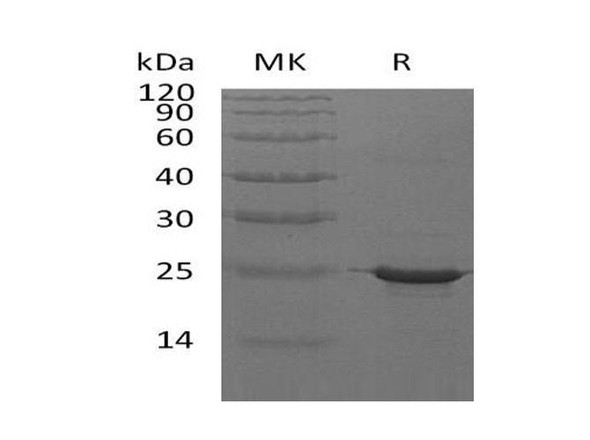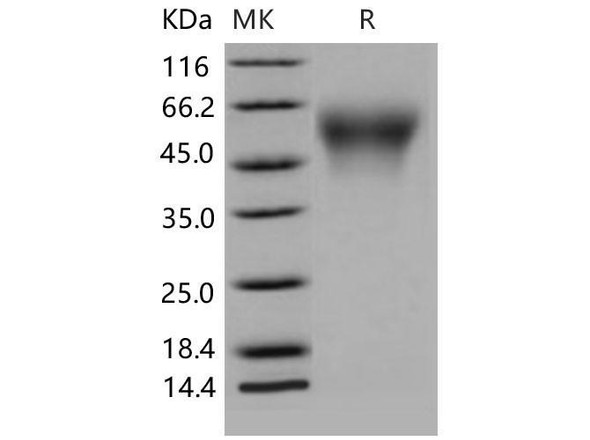Mouse CRYAB Recombinant Protein (RPPB5195)
- SKU:
- RPPB5195
- Product Type:
- Recombinant Protein
- Species:
- Mouse
- Uniprot:
- P23927
Description
| Product Name: | Mouse CRYAB Recombinant Protein |
| Product Code: | RPPB5195 |
| Size: | 20µg |
| Species: | Mouse |
| Target: | CRYAB |
| Synonyms: | CRYA2, CTPP2, HSPB5, Crystallin Alpha B, CRYAB. |
| Source: | Escherichia Coli |
| Physical Appearance: | Sterile filtered colorless solution. |
| Formulation: | The Mouse CRYAB protein solution contains 20mM Tris-HCl buffer pH-8 and 10% glycerol. |
| Stability: | Store at 4°C if entire vial will be used within 2-4 weeks. Store, frozen at -20°C for longer periods of time. For long term storage it is recommended to add a carrier protein (0.1% HSA or BSA).Avoid multiple freeze-thaw cycles. |
| Purity: | Greater than 95.0% as determined by SDS-PAGE. |
| Amino Acid Sequence: | MDIAIHHPWI RRPFFPFHSP SRLFDQFFGE HLLESDLFST ATSLSPFYLR PPSFLRAPSW IDTGLSEMRL EKDRFSVNLD VKHFSPEELK VKVLGDVIEV HGKHEERQDE HGFISREFHR KYRIPADVDP LTITSSLSSD GVLTVNGPRK QVSGPERTIP ITREEKPAVA AAPKK |
Alpha crystallins are composed of two gene products ; alpha-A and alpha-B, for acidic and basic, respectively. Alpha crystallins can be induced by heat shock and are members of the small heat shock protein (sHSP also known as the HSP20). They act as molecular chaperones and hold them in in large soluble aggregates. These heterogeneous aggregates consist of 30-40 subunits; the alpha-A and alpha-B subunits have a 3:1 ratio, respectively. Two additional function of a-crystallins are an autokinase activity and participation in the intracellular architecture. Alpha-B is expressed widely in many tissues and organs and occurs in many neurological diseases.
Recombinant CRYAB Mouse produced in E.Coli is a single, non-glycosylated polypeptide chain containing 175 amino acids and having a molecular mass of 20 kDa. Mouse CRYAB is purified by proprietary chromatographic techniques.
| UniProt Protein Function: | May contribute to the transparency and refractive index of the lens. Has chaperone-like activity, preventing aggregation of various proteins under a wide range of stress conditions. |
| NCBI Summary: | This gene encodes a member of the small heat-shock protein (HSP20) family. The encoded protein is a molecular chaperone that protects proteins against thermal denaturation and other stresses. This protein is a component of the eye lens, regulates lens differentiation and functions as a refractive element in the lens. This protein is a negative regulator of inflammation, has anti-apoptotic properties and also plays a role in the formation of muscular tissue. Mice lacking this gene exhibit worse experimental autoimmune encephalomyelitis and inflammation of the central nervous system compared to the wild type. In mouse models, this gene has a critical role in alleviating the pathology of the neurodegenerative Alexander disease. Mutations in the human gene are associated with myofibrillar myopathy 2, fatal infantile hypertonic myofibrillar myopathy, multiple types of cataract and dilated cardiomyopathy. Alternative splicing results in multiple transcript variants. [provided by RefSeq, Jan 2014] |
| UniProt Code: | P23927 |
| NCBI GenInfo Identifier: | 6753530 |
| NCBI Gene ID: | 12955 |
| NCBI Accession: | NP_034094 |
| UniProt Secondary Accession: | P23927,Q64325, |
| UniProt Related Accession: | P23927 |
| Molecular Weight: | 20kDa (175aa), confirmed by MALDI-TOF. |
| NCBI Full Name: | alpha-crystallin B chain |
| NCBI Synonym Full Names: | crystallin, alpha B |
| NCBI Official Symbol: | Cryab�� |
| NCBI Official Synonym Symbols: | P23; Crya2; HspB5; Crya-2�� |
| NCBI Protein Information: | alpha-crystallin B chain |
| UniProt Protein Name: | Alpha-crystallin B chain |
| UniProt Synonym Protein Names: | Alpha(B)-crystallin; P23 |
| Protein Family: | Alpha-crystallin |
| UniProt Gene Name: | Cryab�� |









